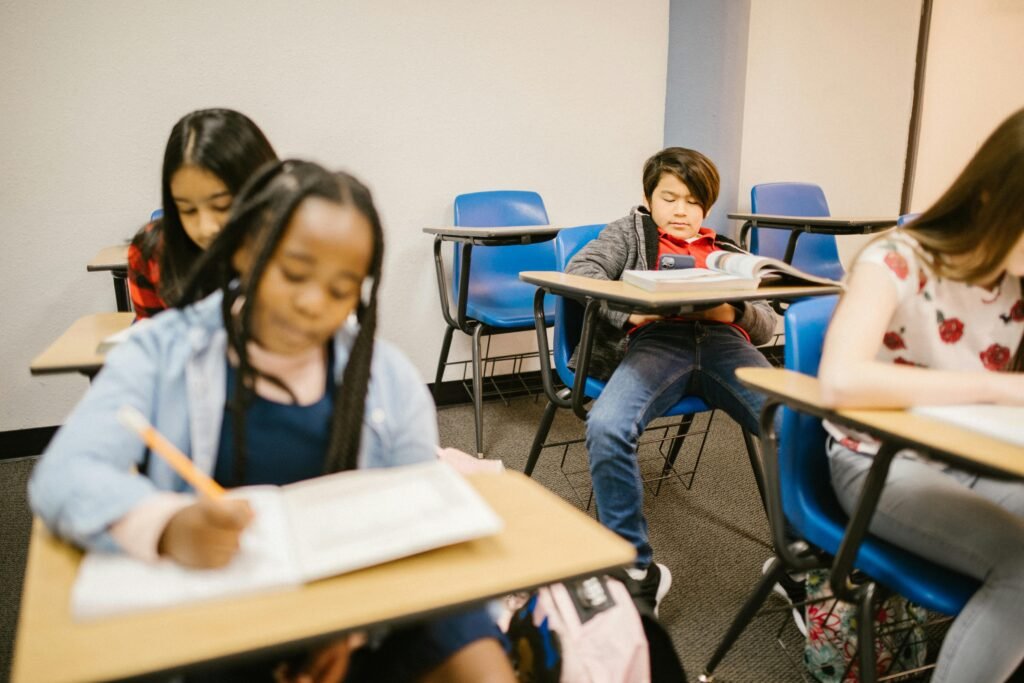Phones are everywhere. In our pockets. In our hands. On our desks. And yes, even in our classrooms. But as schools all over the world start rethinking how phones fit into education, one thing is becoming clear—phones can be a big distraction. That’s why many schools are starting to ban them during the day. And the results? Let’s just say they’re eye-opening.
1. Schools with phone bans saw a 30% drop in classroom distractions
When a school decides to ban phones, the change can feel immediate. Classrooms become quieter. Students look up more. Teachers spend less time asking kids to “put the phone away.” That’s what a 30% drop in classroom distractions really looks like.
It’s not just about noise or movement. Distractions come in many forms—silent texting under the desk, sneaking in a TikTok scroll, or just thinking about who might be messaging them right now. Phones pull attention away from learning. And when you remove them, you remove that constant mental tug.
Now, does that mean students love the idea at first? Not always. But after a while, most admit they feel better without the pressure to check their phones. They start focusing more on what the teacher is saying, asking better questions, and actually remembering what they learn.
If you’re a school thinking of banning phones, start small. Test it for a few weeks. Create clear rules. Let students know why it matters. And most of all, help them understand it’s not a punishment—it’s a chance to learn better.
Teachers can help too. Instead of just saying “no phones,” try saying what students will gain: more peace, better focus, and even less homework since they’ll get more done in class.
2. 82% of teachers say phones negatively affect students’ focus
When you ask teachers about phones in class, they don’t hold back. Over 8 out of 10 say phones are hurting students’ ability to focus. And that makes sense—teachers see it every day. A student may look down at their lap every few minutes.
Their eyes glaze over. They miss key parts of the lesson. All because of a buzzing or glowing screen.
But here’s what’s even more interesting. Teachers don’t just notice students checking phones. They see how it affects the whole mood. Kids get restless. They want to see what their friends are laughing about. They’re not “in the room” anymore.
Focus is a skill. It’s like a muscle that gets stronger the more you use it. But phones make it harder to build that skill. They offer instant fun and rewards, which can make reading or thinking deeply feel boring in comparison. That’s not the child’s fault—it’s just how our brains work.
That’s why many teachers are asking for phone bans. Not because they don’t trust students—but because they want them to build habits that will help them far beyond the classroom.
If you’re a parent, you can help by talking with your child about why schools are making this shift. Support the school’s rules at home. Let them know you’re on the same team.
3. After phone bans, student test scores increased by 6.4% on average
This one speaks for itself. After phones are removed from the classroom, test scores go up. By more than six percent on average. That’s a big deal.
Think about it like this: If a student was getting 70% on their math test, they could jump up to over 76%—just by changing the environment. No new textbooks. No extra homework. Just fewer distractions.
That’s powerful.
Why does this happen? Because focus improves. When students are present, they absorb more. When they’re not worried about missing a Snapchat, they give more attention to the material. They ask questions. They understand better. And that shows up on the test paper.
For school leaders, this stat is gold. It shows that removing phones isn’t about control—it’s about results. And for parents? It’s reassurance. If you were worried that your child might fall behind without their phone, know this: the data says the opposite.
To make this kind of improvement stick, schools need to make sure the environment is supportive. Help students adjust. Provide alternatives during breaks—like games, books, even time to chat. Make school a place where focus is rewarded and learning feels good.
4. 75% of school leaders report better classroom behavior post-ban
When phones go, so do a lot of the behavior issues. Seventy-five percent of principals and school leaders say classroom behavior improved after banning phones. That’s huge.
Why does this happen? Simple. Phones are often the root of conflict. They’re used to take photos without permission, start group chats that distract or exclude others, and even record teachers during lessons. Take them out of the equation, and things get calmer.
But there’s more to it. Students are also less anxious when phones aren’t around. They don’t worry as much about likes or texts. And when they’re not constantly interrupted by notifications, they’re less irritable and more respectful.
Teachers find they spend less time managing behavior and more time teaching. That makes their job easier and their classrooms more productive.
Want to see this kind of improvement in your school? Involve students in the conversation. Let them help create the phone rules. Ask for their input. When they feel like their voices matter, they’re more likely to respect the rules.
And when things go wrong? Don’t just punish—teach. Use those moments to talk about responsibility, boundaries, and respect. Those are lessons that go beyond any classroom.
5. 1 in 3 students checks their phone more than 10 times during a single class
Let that sink in. One out of every three students is looking at their phone over 10 times during just one class period. That’s like checking every five minutes.
This stat shows how powerful the habit has become. It’s not just about texting or social media. It’s about the need to check. To not miss out. To stay connected. But that habit comes at a cost.
Each time a student checks their phone, their focus is broken. And it takes time to get it back. Research shows it can take several minutes to refocus after a distraction. That means even a few glances at the phone can steal most of the lesson.
Some students don’t even realize they’re doing it. It’s automatic. Like breathing. But that’s why school phone policies matter. They help interrupt that pattern.
Teachers can use this stat to start conversations. Ask students, “How many times do you think you check your phone in class?” Most will guess too low. Then show them the truth. Let them track it for a day. Awareness is the first step to change.
And for families? Try “tech-free homework time” at home. Make a rule that phones go in another room while homework is done. Help students experience what deep focus feels like. It’s hard at first. But the results are worth it.
6. Schools that banned phones saw a 21% drop in bullying incidents
One of the hidden costs of phones in schools is bullying. And it’s not always the kind you can see. With phones, bullying has moved online—and it can follow kids wherever they go. But in schools where phones were banned during the day, bullying dropped by 21%. That’s a powerful shift.
Without phones, students can’t take sneaky photos. They can’t record videos to post or share without consent. They can’t send cruel messages in secret chats during class time. This cuts off the fuel source for a lot of school-based bullying.
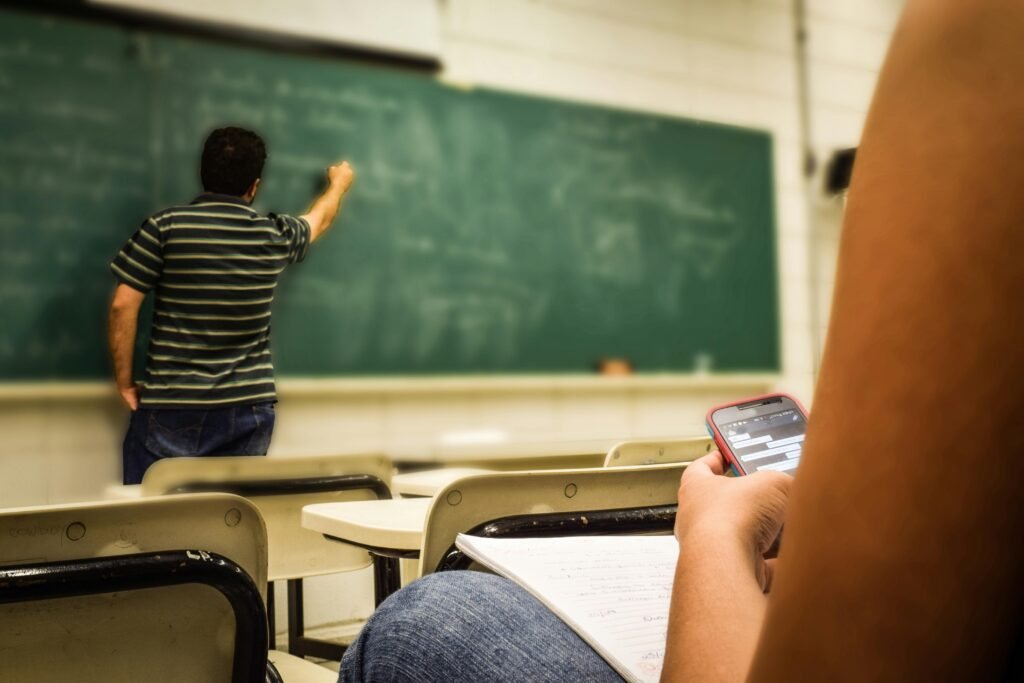
Even more important, students who might feel targeted get a break. They’re not constantly seeing mean comments or being pulled into drama. They get space to breathe and be themselves, without the constant buzz of judgment.
For schools, this stat shows how phone bans protect students emotionally, not just academically. They create safer, kinder spaces. But it doesn’t happen by itself. Staff need to support the rule, enforce it consistently, and also be ready to help students who may already be struggling with social pressure or bullying online.
Parents can also take this moment to check in. Ask your child if they feel safer at school now. Remind them that no text, photo, or comment is more important than their well-being. And let them know you’re there, no matter what.
7. 90% of students admit to texting during class at least once
It might sound shocking, but it’s true. Almost every student—90%—admits they’ve texted during class at least once. And if we’re honest, it’s likely more than once.
It could be a quick message to a friend. A group chat about what’s happening in class. Or even a text to a parent. But no matter the reason, the result is the same: lost focus.
When students text, they aren’t fully present. Even a short text can pull them out of the learning moment. And over time, that adds up. Missed instructions. Missed details. Missed chances to engage.
So what can schools do?
A clear, no-texting policy is a good start—but it’s not enough on its own. You need buy-in. Students need to know why the rule exists. Talk about how focus helps them do better, feel better, and succeed.
Teachers can also lead by example. Keep phones away during class. Avoid using them unless absolutely necessary. Create a shared culture of attention and respect.
And for parents: try waiting to text your child during school hours unless it’s urgent. If they know you won’t message them until the end of the day, they’ll be less tempted to keep checking.
8. 50% reduction in physical altercations reported in schools with phone bans
Yes, you read that right. In schools where phones were banned, physical fights went down by half. That’s not just a stat—it’s a big shift in how safe kids feel during the day.
Phones don’t cause fights directly, but they do create tension. Someone might take a photo that wasn’t wanted. A private message might get shared. A post could be misread, misunderstood, or seen by the wrong person. Suddenly, a small issue turns into a big one.
Without phones, these sparks don’t get the fuel they need to turn into fire. Things don’t escalate as quickly. Arguments have space to cool down. And that means fewer fights—and fewer kids getting hurt.
For schools, this is one of the strongest arguments for a phone ban. It’s not just about focus. It’s about safety. It’s about creating a space where students can learn without fear.
Teachers and administrators can take this stat and turn it into action by building strong conflict-resolution programs. Teach students how to deal with disagreement in a healthy way. Offer safe places to talk things out. Show that respect and kindness aren’t just rules—they’re life skills.
9. Screen time during school hours dropped by 58% after phone bans
This stat says a lot. When phones are banned, screen time doesn’t just drop—it plummets. By more than half.
That’s a major win, especially when you consider how much time kids already spend on screens outside of school. A break during the school day gives their minds a chance to rest. It helps their eyes. Their posture. Their sleep later that night.
But more than anything, it helps their brains. Less screen time means more time thinking, reading, writing, and talking. More time interacting face to face. More chances to build real, lasting skills.
Some students may push back at first. That’s normal. Screens feel like part of who they are. But schools can help by offering strong alternatives—creative assignments, games, discussions, and real-world problem-solving.
And parents can do the same at home. Talk about balance. Encourage non-screen hobbies. Show that there’s more to life than scrolling. And remember: the goal isn’t to ban screens forever. It’s to help kids use them well, not be ruled by them.
10. 67% of parents support phone bans during school hours
This stat is encouraging. It shows that parents are on board. Nearly 7 out of 10 support the idea of phone bans during the school day.
That’s important, because lasting change only happens when families and schools work together. When both sides support a rule, students take it more seriously.
Parents understand what’s at stake. They’ve seen their children zone out in the middle of homework. They’ve had to remind them again and again to get off the phone and go to bed. And they know how hard it is to break the habit.
That’s why many parents welcome phone bans. It gives their kids a chance to learn, focus, and breathe without the constant buzz of notifications.
If your school is thinking of implementing a ban, talk to parents early. Share the benefits. Give them the stats. Let them ask questions. And be clear about what the rules are and how they’ll be enforced.
Parents can reinforce the message at home, too. Ask your child how their day felt without the phone. Celebrate small wins. And let them know you’re proud of their ability to stay present. Those moments matter more than you think.
11. Schools with bans observed a 39% increase in peer interaction during breaks
When phones are taken out of the picture, something simple but powerful starts to happen—kids start talking to each other again. In schools that banned phones during the day, peer interaction during breaks jumped by 39%. That means more face-to-face conversations, more laughter, and more real connection.
It might seem small, but it’s a big deal. These moments—chatting at lunch, playing games at recess, telling stories between classes—are how kids build social skills. They learn how to read body language. How to respond. How to share and solve problems together.
When phones are allowed, those social chances shrink. You’ll often see students sitting next to each other but not talking, each lost in their own screen. And while they might be texting friends, they miss out on real-life interactions that build confidence and empathy.
For schools, encouraging these face-to-face moments doesn’t just improve behavior. It improves emotional growth. It gives shy students a chance to speak up. It helps new friendships form. It makes school feel less lonely.
To make this even stronger, schools can create activities that bring kids together during breaks. Board games, outdoor games, art corners, music—anything that invites connection. And parents can help by encouraging playdates or hangouts that don’t revolve around screens. When students feel more connected, they feel more seen. And that changes everything.
12. 41% fewer classroom disruptions were reported in phone-free schools
Classroom disruptions can take many forms. A ringtone going off. A student laughing at a meme. A sneaky text being passed under the desk. All of these break the flow of learning. But when schools ban phones, disruptions drop—by 41%.
That’s nearly half. Imagine what a teacher can do with that extra calm. Imagine how much more a student can learn when they aren’t being interrupted by someone else’s screen time.
It’s not just about keeping order. It’s about protecting focus. When disruptions go down, students have more time to think, more room to ask questions, and more space to absorb what they’re learning.
And teachers benefit too. They spend less time managing behavior and more time teaching. Their stress goes down. Their joy goes up. And that creates a better classroom for everyone.
To support this, schools can train teachers on positive behavior strategies that keep attention high without being harsh. Classroom routines. Clear expectations. Fun transitions. These all help maintain flow.
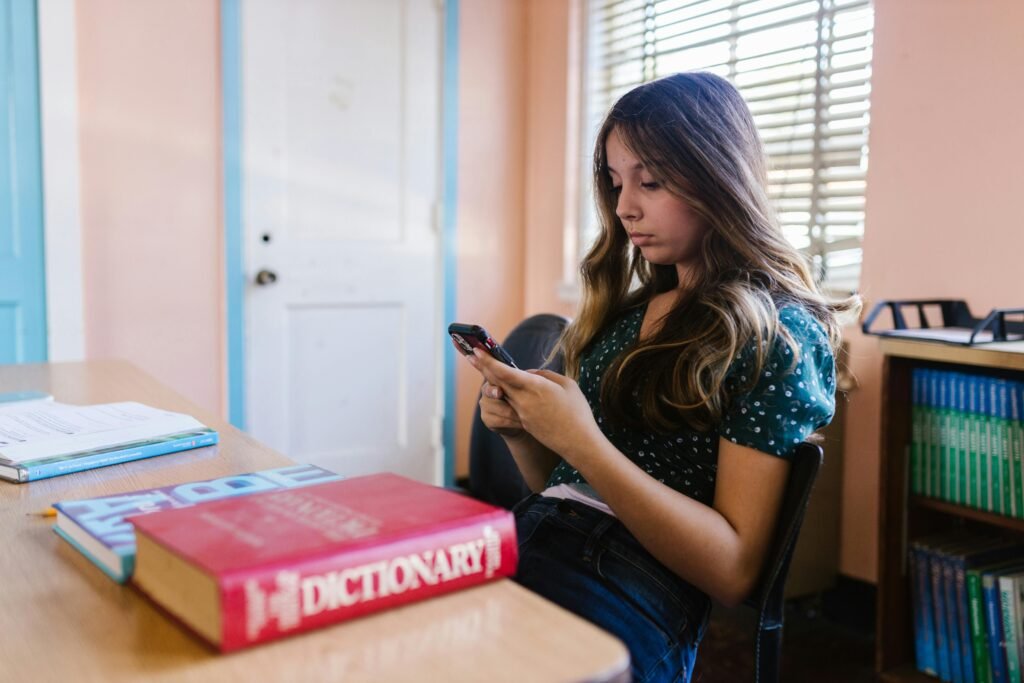
Parents can back this up at home by teaching kids the value of focus. Try quiet reading times, no-phone dinners, and screen-free zones. Show them that full attention is not just for school—it’s a life skill that will serve them everywhere.
13. Students with no phone access perform 10% better in math assessments
Math is one of those subjects that really needs deep focus. It’s not just about memorizing facts—it’s about problem-solving, pattern recognition, and critical thinking. So when phones are taken away, and distractions go down, scores go up.
In fact, students without phone access during the day perform 10% better in math. That’s not a small bump. That’s the difference between struggling and succeeding.
This stat tells us something important. Learning—especially in subjects like math—requires more than just being present. It requires attention, persistence, and a clear mind. Phones chip away at all three. They break up thought patterns. They interrupt that “aha” moment. They make it harder to push through a tricky problem.
For schools, the takeaway is clear: If you want better academic results, create a focused learning environment. For teachers, build lessons that reward deep thinking, not just speed.
And for families? Help kids approach math with a calm, steady mindset. That might mean doing math homework in a quiet room. Or practicing math games without screens. Show your child that when their brain is fully engaged, they can do amazing things.
14. 60% of cyberbullying incidents originate during school hours
This stat is heartbreaking—but important. Over half of cyberbullying incidents begin during school hours. That means it’s not just an after-school problem. It’s happening in real time, right under the school roof.
Phones give bullies instant access to their targets. A cruel message, a group chat joke, a shared photo—it can all happen in seconds. And it often does. But when phones are banned, those opportunities shrink.
Without devices, students can’t post, comment, or screenshot while class is going on. That cuts off the cycle. It gives everyone a break from the pressure. And it gives schools a better chance to notice when something is wrong.
To make the most of this, schools should pair phone bans with strong anti-bullying programs. Teach students what cyberbullying is, how to report it, and how to stand up against it. Don’t wait for a problem to grow—talk early and often.
Parents can also help by checking in regularly. Ask your child how things are going online. Who they talk to. What kind of messages they get. Keep the door open, without judgment. Let them know they’re not alone, no matter what.
15. 25% fewer tardies recorded in schools with phone bans
Here’s something you might not expect: When phones are banned, students actually show up to class on time more often. In fact, schools with bans saw a 25% drop in tardiness.
Why? Because phones are often the reason students drag their feet. They’re finishing a video. Replying to a message. Checking one last post before walking in. And then… they’re late.
Phones also play a role in time management. When students rely on their phones to tell time—but also get distracted by everything else—it’s easy to lose track.
Taking phones out of the equation helps students stay present. It reminds them of routines. It shifts their focus from what’s happening online to what’s happening now.
For schools, this makes a big difference. Less tardiness means smoother classes. Fewer disruptions. More learning time. And better habits that students carry into life beyond school.
Teachers can support this by creating strong start-of-class routines. A warm greeting. A clear activity. A reason to be there on time. Make the first minutes of class matter.
And at home? Try helping your child set a morning routine that doesn’t involve their phone. An alarm clock. A good breakfast. A few quiet minutes to get centered. These small steps build habits that lead to big success.
16. Student attention span increased by 24% when phones were banned
Attention is like a window. When it’s wide open, learning flows in easily. But when it keeps getting shut—by texts, notifications, or apps—it becomes harder and harder to learn. That’s why this stat is so important. In schools that banned phones, students’ attention span increased by 24%. That’s nearly a quarter more time that their minds stayed focused.
Why does this happen? Because phones are designed to pull attention. Every ding, buzz, or even the thought of a message can snap focus in an instant. And each time that happens, it takes several minutes to get back into deep concentration.
But when phones are removed, students can finally stay “in the zone.” They listen longer. They think deeper. They connect ideas more clearly. And that leads to better learning—not just more, but smarter.
For teachers, this opens up all kinds of possibilities. Lessons can go deeper. Class discussions can stretch further. Group work becomes more productive.
And at home, families can mirror this by creating no-phone study times. Try setting a 20-minute timer where all devices are off, and your child just focuses on one task. Then take a short break and do it again. Over time, their attention muscle grows stronger—and that helps in every part of life.
17. 9 out of 10 teachers feel phone bans improve learning outcomes
Teachers know what works. They see how students respond. So when 9 out of 10 teachers say phone bans improve learning, it’s worth listening.
This isn’t just a small opinion. It’s a near-universal view from people on the front lines of education. They’ve seen the before and after. They’ve taught classes with phones and without them. And they’ve seen the difference in focus, effort, and performance.
Teachers notice when students are more present. When they ask more thoughtful questions. When they start finishing their work—not just faster, but with more care. And that’s what improved outcomes really look like.
For school leaders, this stat is a green light. It says your teachers are ready. They want this change. They believe in it. Give them the support to make it happen.
And for parents, it’s a chance to trust the educators. If your child’s teacher supports a phone ban, ask them why. They’ll probably share stories of students who struggled before—and started to shine afterward.
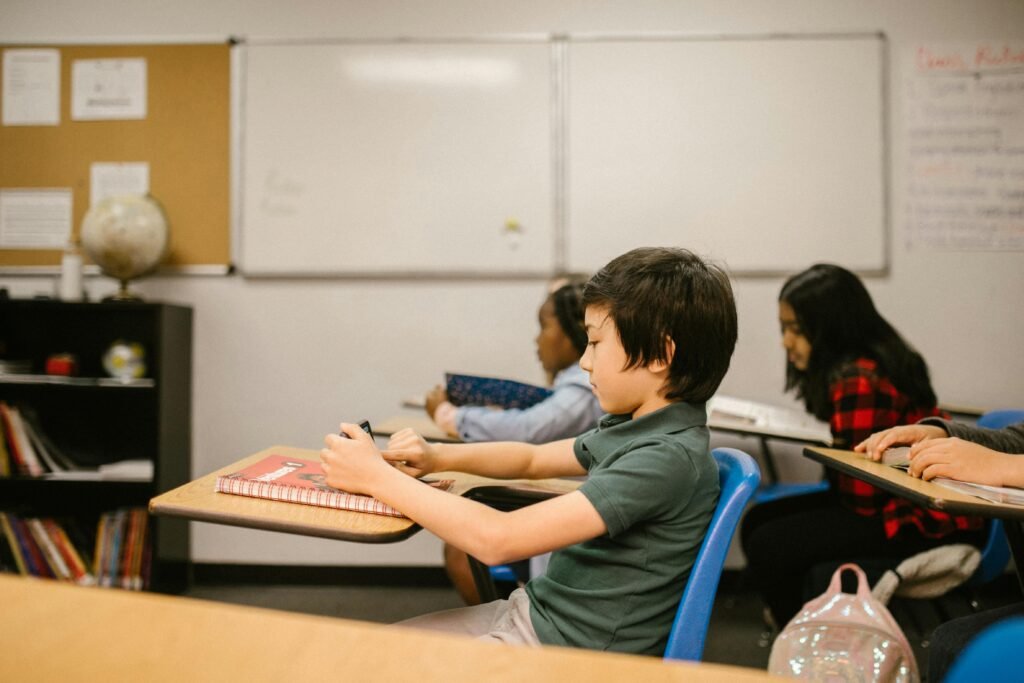
Support your teachers. Back them up. When everyone’s on the same team, kids win.
18. 32% drop in cheating incidents noted in phone-restricted classrooms
Cheating is one of those things that schools have always battled. But with smartphones, it got a lot easier. Students can search answers, text friends, or take photos of tests without anyone noticing. That’s why phone-restricted classrooms have seen a 32% drop in cheating.
When phones aren’t allowed, temptation drops too. It’s not just about removing the tool—it’s about removing the stress and pressure that often lead to cheating in the first place.
Without phones, students are more likely to try their best, even if the work is hard. They know they’ll have to rely on their own brain, not a search engine. And that builds real confidence.
For schools, this stat is a powerful motivator to take academic honesty seriously. Make the rules clear. Teach why honesty matters—not just for grades, but for life. And be ready to support students who need extra help.
Teachers can design assessments that reward thinking, not just memory. Open-ended questions. Real-world problems. Group discussions. These make cheating less useful and learning more rewarding.
And families? Talk about integrity at home. Remind your child that success means more when it’s earned. Praise the effort, not just the grade. And show that you care more about honesty than perfection.
19. Teachers regain an average of 15 minutes per class when phones are removed
Time is precious in the classroom. Every minute matters. So imagine what it means when teachers regain 15 extra minutes per class just by banning phones. That’s a full hour every four classes. That’s huge.
Why does this happen? Because phones waste time. Teachers lose time asking students to put them away. They lose time waiting for students to re-focus. They lose time dealing with distractions, arguments, or tech issues.
Take the phones out, and suddenly, that time comes back. Classes start quicker. Transitions are smoother. Activities move faster. There’s more room for questions, projects, and deeper learning.
For teachers, this is a game-changer. It means more time to build relationships. To support struggling students. To create a calm, focused space where learning feels good.
Schools can support this by making the policy clear and consistent. No gray areas. No special exceptions. The clearer the rule, the smoother the class.
Parents can also help by talking to their kids about respect. When a student leaves their phone in their bag or locker, they’re showing respect—for the teacher, the lesson, and themselves.
That respect goes a long way. It builds a stronger classroom. And it gives everyone back the most valuable thing: time.
20. 45% fewer emergency room visits linked to school fights after bans
This stat is serious. In schools where phones were banned, emergency room visits due to fights dropped by 45%. That’s nearly half as many students getting hurt badly enough to need a hospital.
How does a phone cause a fight? Sometimes it’s a photo shared without permission. Sometimes it’s a group chat gone wrong. Other times, it’s a post that spreads fast and turns students against each other.
Phones don’t just record drama—they amplify it. They make it public. They make it permanent. And they often make it worse.
Take phones away during the day, and much of that tension disappears. Students still have disagreements, but they don’t spiral out of control as quickly. They don’t feel the need to “get back” at someone online. And that means fewer fights, fewer injuries, and fewer lives shaken by violence.
For school leaders, this is more than a policy choice—it’s a safety issue. A phone ban can literally protect your students from harm.
Teachers can also help by building strong, respectful communities in the classroom. Teach kindness. Model empathy. Notice when a student seems upset and check in before it grows.
And for families? Don’t wait for a problem to start. Talk early about how your child uses their phone. Help them understand the impact their words and actions can have. Give them tools to handle conflict without violence.
21. Only 8% of students miss their phones after a week without them in school
This one surprises a lot of people—but it’s true. After just one week of being without their phones during school hours, only 8% of students say they miss them. That means over 90% actually adjusted just fine, or even felt better.
At first, students may resist a phone ban. They worry about being bored. Or cut off. Or feeling awkward during breaks. But when the phone is removed and they get used to a different rhythm, many students actually feel relieved.
They talk more. They play more. They feel less pressure to keep up with social media or respond instantly to every message. The constant mental “buzz” fades. And school becomes a calmer, more focused space.
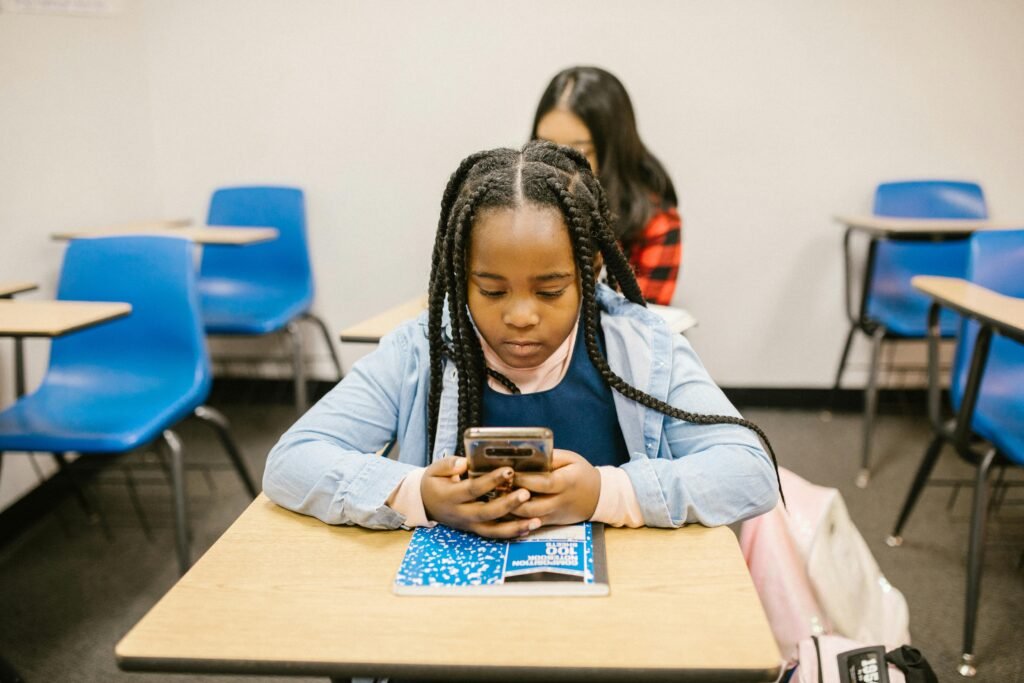
For schools, this is a reminder to stay the course. The first few days might feel rocky. There may be pushback. But give it time. Set clear expectations. Offer support. And trust that students will adapt.
Teachers can help by offering fun, screen-free options during free time. Trivia questions on the board. Brain puzzles. Art stations. Little things that make break times feel full—even without a phone.
And parents? This is your chance to say, “Let’s try it at home too.” Create phone-free times in the evening. Show your child that they’re stronger than they think. That the phone doesn’t control them—they control it.
22. Students engage in 50% more physical activity during recess in phone-free schools
Phones don’t just take students’ focus. They take their movement too. In schools that banned phones during the day, physical activity during recess jumped by 50%. That’s half again as many students running, playing, jumping, and moving their bodies.
This matters more than we often realize. Kids need movement to stay healthy, alert, and emotionally balanced. Physical activity boosts mood, improves sleep, and even helps with memory and learning.
When phones are around, students often sit. They scroll. They stay in one place. Even during breaks, they stay still. But take phones out of the mix, and kids get moving again. They play tag. They shoot hoops. They invent games with sticks and chalk.
For schools, this is a great opportunity to rethink recess. Add equipment. Mark off games. Invite staff to play along. Make the yard or playground a place where students want to be—not just a space to pass time.
Teachers can also incorporate movement into the school day. Stretch breaks. Dance moments. A short walk around the classroom. When students move, they learn better.
Parents, you can join in too. Encourage outdoor time after school. Take walks together. Limit phone time before bed and replace it with movement. It doesn’t have to be big—just something to keep bodies and minds active.
23. 20% of school anxiety cases are tied to phone use and social media
This stat is hard—but important. One out of every five cases of school-related anxiety is directly tied to phone use and social media. That’s not just about too much screen time—it’s about the mental weight of being online all the time.
Students worry about likes, followers, comments, and how they look in photos. They compare themselves to others. They see drama, hate, or exclusion—and it affects their self-worth. Sometimes, they even fear going to school because of what’s being said or shared about them online.
When phones are banned at school, that anxiety drops. Students get a break. They stop checking. They stop comparing. They start living in the real moment, not the online one.
Schools can support this by talking openly about mental health. Don’t just ban phones—teach students why. Talk about stress, self-image, and healthy boundaries. Invite school counselors to give workshops. Create a space where students feel safe to share.
Teachers can also keep an eye out for signs of stress. A student who seems withdrawn. A sudden change in behavior. These might be clues that something’s going on online.
Parents should talk about it too. Ask how your child feels about social media. Listen without judgment. Be their guide, not just their rule-maker. Let them know that taking breaks from the phone is not weakness—it’s strength.
24. 71% of educators say phone bans create a calmer school environment
Teachers and school staff don’t just notice better focus. They feel the whole vibe of the school shift. In fact, 71% of educators say that banning phones makes the school feel calmer overall.
It’s the little things. The quiet buzz of students chatting face-to-face instead of shouting over TikTok videos. The sense of presence in the classroom. The slower pace in hallways. The way lunchrooms sound more like conversations and less like constant dings and screen noises.
Calm doesn’t mean boring. It means balanced. Focused. Healthy. And in that calm, students feel safer. They behave better. They treat each other with more kindness.
For school leaders, this is a clear sign that the benefits of phone bans go far beyond test scores. They touch the heart of school life—the culture, the relationships, the well-being.
Teachers can nurture this calm by modeling it. Using a calm tone. Keeping consistent routines. Celebrating quiet moments of learning. Not every minute needs to be high-energy. Peace has power too.
At home, families can bring this same idea into their daily lives. Make certain times phone-free—like meals or bedtime. Create space where calm is the goal, not constant stimulation. Show your child that rest is good, and that quiet doesn’t have to be awkward. It can be peaceful.
25. Schools report 28% more homework completion after banning phones
Homework is a big part of school success—but phones often get in the way. They offer a thousand distractions: games, chats, videos, apps. That’s why schools with phone bans saw a 28% jump in homework completion. When students aren’t checking their phones all day, they’re more likely to actually finish what they start.
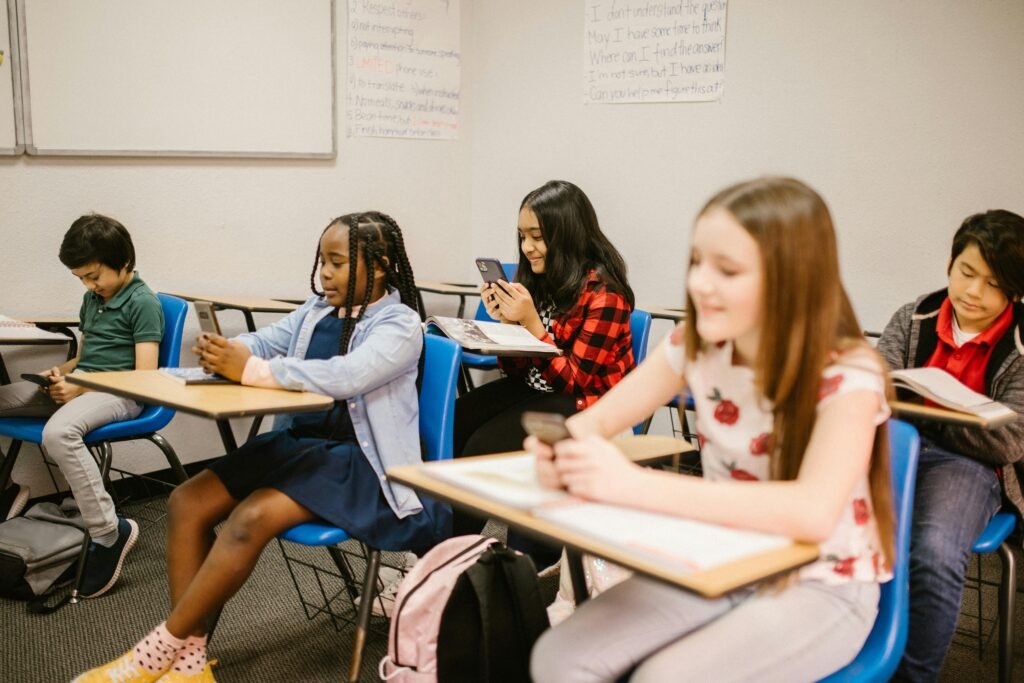
This happens for a few reasons. First, students pay more attention in class—so they understand the homework better. Second, they build better habits of focus and time management. And third, they’re not stuck in the “scrolling spiral” when they get home.
Teachers notice it too. Assignments come in on time. They’re done with more care. Students ask better questions the next day.
To keep this going, schools can teach time management skills directly. Short sessions on how to break big tasks into small ones. How to set timers and avoid distractions. How to feel proud of finishing something hard.
Teachers can also be flexible. Offer choice in assignments. Give students the chance to work on projects they care about. When work feels meaningful, students are more likely to complete it.
Parents can help by setting up a good study space. No phones. No TV. Just a table, a timer, and a calm place to work. Celebrate when the homework gets done. Let your child know you see their effort—and it matters.
26. 50% reduction in social isolation among students without phone access
School should be a place where students feel connected. But for many, especially in the age of constant social media, school can feel lonely. Phones often make this worse, not better. But when schools banned phones, social isolation was cut in half. That’s a 50% reduction in students feeling alone or left out.
It might seem strange. After all, phones connect us, right? But in many cases, they do the opposite. Students get caught up watching others instead of joining in. They sit together but scroll alone. They worry they’re not part of the group, even when they are.
When phones are removed, something beautiful happens. Students start to notice each other again. They look up. They talk. They laugh together. They start playing games, starting conversations, forming real connections—not filtered ones.
Teachers see it too. Students include one another more. Shy kids find it easier to join in. The class becomes a team, not just a group of people in the same room.
For schools, this is a reminder to build community in every way possible. Pair students up. Mix seating often. Create buddy systems. Every little effort matters.
Parents, keep an eye out at home. Ask your child how they feel about their friendships. Encourage in-person hangouts. Plan screen-free activities. Remind them that being seen and valued is better than being “liked.”
27. 42% increase in participation during discussions in phone-free classrooms
Class discussions are one of the most powerful tools in learning. They build confidence, language, critical thinking, and listening skills. But phones often keep students quiet. They’re distracted or self-conscious. When phones are banned, schools see a 42% boost in participation during discussions.
That’s not just more hands going up. It’s more students thinking deeply. More voices being heard. More confidence growing.
In a phone-free room, students feel more connected to the moment. They’re not half-thinking about a message or post. They’re truly present. And when they’re present, they speak up.
Teachers can build on this by making discussions safe and fun. Use open questions. Accept all ideas. Praise risk-taking. Celebrate not just the “right answer,” but thoughtful thinking.
And if you’re a parent? Try having screen-free dinner talks. Ask open questions: “What surprised you today?” or “What do you think about…?” Help your child practice their voice. It doesn’t have to be polished—just real.
28. Teachers report 35% more respect and eye contact in classrooms without phones
Something powerful happens when students are no longer looking down at a screen—they look up, and into someone’s eyes. In phone-free classrooms, teachers report a 35% increase in respectful behavior, especially in how students make eye contact and listen.
That’s a big deal. Eye contact builds trust. It creates a real connection between student and teacher. And it helps students engage not just with the lesson—but with the people around them.
Respect in a classroom isn’t just about being quiet. It’s about presence. Engagement. Listening. Saying “thank you.” Looking someone in the eye when they speak. Phones make this harder. They create distance. But take them away, and kids rediscover those basic, human skills that matter in every part of life.
Teachers can support this with simple reminders. Practice listening activities. Reflect after discussions. Praise respectful behavior when they see it.
At home, model it. Put your phone down when your child talks to you. Look them in the eye. Listen fully. They’ll mirror that—and carry it back into their classroom.
29. 80% of detentions in phone-allowed schools are phone-related
In schools where phones are allowed, 80% of detentions are related to phones. That’s four out of every five. Whether it’s using the phone during class, recording others, texting during tests, or causing drama on social media—it almost always ties back to the device.
This tells us something loud and clear: phones are the biggest behavior trigger in many schools today.
When phones are removed, most of those issues vanish. Students still make mistakes—that’s part of growing up—but one of the biggest behavior problems disappears.
That frees up teachers to focus on learning. It frees up students to focus on success. And it reduces tension between schools and families.
For administrators, this stat makes a strong case for change. A clear phone policy can cut down detentions, reduce conflict, and improve the overall tone of the school.
And for parents? It’s worth talking with your child about school rules. Make sure they understand the why, not just the what. Let them know that school isn’t just about what they learn—it’s about how they grow.
30. Students in phone-free schools report feeling 33% less pressure from social media
Last but definitely not least, this stat hits at the heart of what so many students feel but rarely say: pressure. In phone-free schools, students say they feel 33% less pressure from social media.
Less pressure to post. To respond. To look perfect. To keep up. To not be left out.
That’s huge.
This pressure affects how kids see themselves. How they act. How they sleep. How they feel when they walk into a classroom. When phones are gone, that stress eases. Students feel more like themselves, and less like they have to perform.
They stop thinking about the likes. They start thinking about real life.
This kind of shift is deeply emotional. And it’s deeply needed.
Schools can support this by starting conversations. Invite students to reflect: “What do you like about social media? What don’t you like? What would change if you took a break?” Help them take back control of their digital lives.
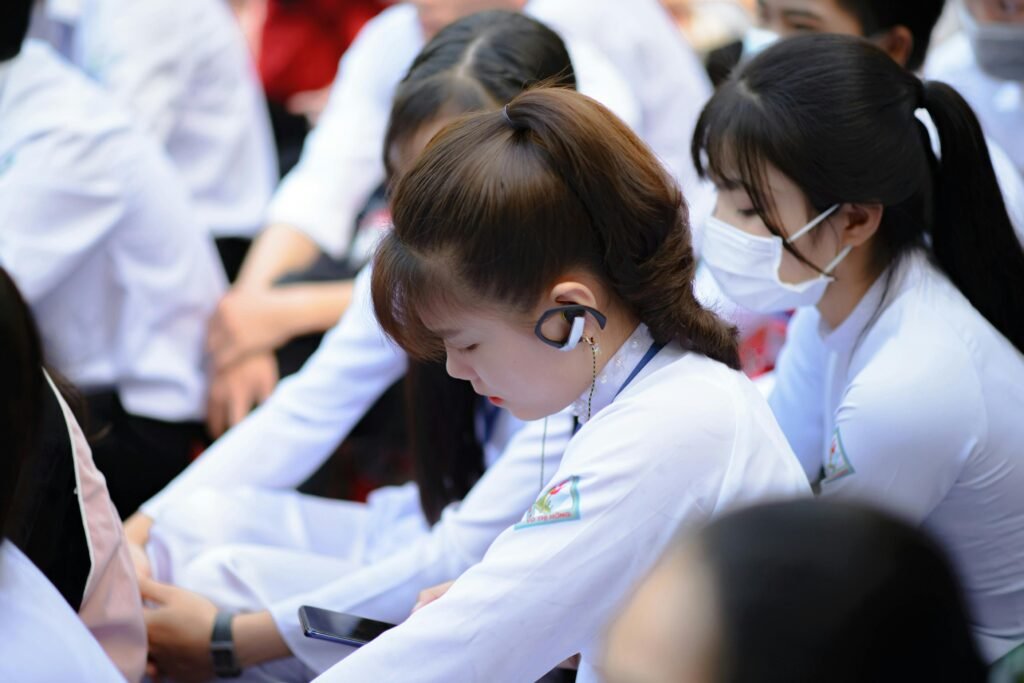
Parents, you can be a powerful example. Take breaks from social media yourself. Talk openly about it. Show your child that self-worth doesn’t come from a screen—but from within.
Conclusion
Phones are powerful tools. They connect us, inform us, entertain us. But in the hands of students during school hours, they often become barriers—barriers to learning, to friendships, to peace of mind.
This article walked you through 30 powerful stats that show what really happens when schools remove phones from the classroom. And the message is clear: when the phone goes away, good things begin.
Focus returns. Students become more engaged. Test scores rise. Bullying drops. Conversations bloom. Physical activity increases. Respect deepens. Anxiety falls. And most importantly, students start to feel like themselves again—free from the weight of constant comparison and distraction.
